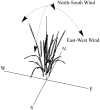The 4-Dimensional Plant: Effects of Wind-Induced Canopy Movement on Light Fluctuations and Photosynthesis
- PMID: 27708654
- PMCID: PMC5030302
- DOI: 10.3389/fpls.2016.01392
The 4-Dimensional Plant: Effects of Wind-Induced Canopy Movement on Light Fluctuations and Photosynthesis
Abstract
Physical perturbation of a plant canopy brought about by wind is a ubiquitous phenomenon and yet its biological importance has often been overlooked. This is partly due to the complexity of the issue at hand: wind-induced movement (or mechanical excitation) is a stochastic process which is difficult to measure and quantify; plant motion is dependent upon canopy architectural features which, until recently, were difficult to accurately represent and model in 3-dimensions; light patterning throughout a canopy is difficult to compute at high-resolutions, especially when confounded by other environmental variables. Recent studies have reinforced the expectation that canopy architecture is a strong determinant of productivity and yield; however, links between the architectural properties of the plant and its mechanical properties, particularly its response to wind, are relatively unknown. As a result, biologically relevant data relating canopy architecture, light- dynamics, and short-scale photosynthetic responses in the canopy setting are scarce. Here, we hypothesize that wind-induced movement will have large consequences for the photosynthetic productivity of our crops due to its influence on light patterning. To address this issue, in this study we combined high resolution 3D reconstructions of a plant canopy with a simple representation of canopy perturbation as a result of wind using solid body rotation in order to explore the potential effects on light patterning, interception, and photosynthetic productivity. We looked at two different scenarios: firstly a constant distortion where a rice canopy was subject to a permanent distortion throughout the whole day; and secondly, a dynamic distortion, where the canopy was distorted in incremental steps between two extremes at set time points in the day. We find that mechanical canopy excitation substantially alters light dynamics; light distribution and modeled canopy carbon gain. We then discuss methods required for accurate modeling of mechanical canopy excitation (here coined the 4-dimensional plant) and some associated biological and applied implications of such techniques. We hypothesize that biomechanical plant properties are a specific adaptation to achieve wind-induced photosynthetic enhancement and we outline how traits facilitating canopy excitation could be used as a route for improving crop yield.
Keywords: canopy; light; mechanical canopy excitation; modelings; movement; photosynthesis; wind.
Figures





Similar articles
-
A canopy conundrum: can wind-induced movement help to increase crop productivity by relieving photosynthetic limitations?J Exp Bot. 2019 Apr 29;70(9):2371-2380. doi: 10.1093/jxb/ery424. J Exp Bot. 2019. PMID: 30481324
-
Exploring Relationships between Canopy Architecture, Light Distribution, and Photosynthesis in Contrasting Rice Genotypes Using 3D Canopy Reconstruction.Front Plant Sci. 2017 May 17;8:734. doi: 10.3389/fpls.2017.00734. eCollection 2017. Front Plant Sci. 2017. PMID: 28567045 Free PMC article.
-
The effect of canopy architecture on the patterning of "windflecks" within a wheat canopy.Plant Cell Environ. 2021 Nov;44(11):3524-3537. doi: 10.1111/pce.14168. Epub 2021 Aug 30. Plant Cell Environ. 2021. PMID: 34418115
-
The Impacts of Fluctuating Light on Crop Performance.Plant Physiol. 2018 Feb;176(2):990-1003. doi: 10.1104/pp.17.01234. Epub 2017 Nov 30. Plant Physiol. 2018. PMID: 29192028 Free PMC article. Review.
-
Variation in leaf photosynthetic capacity within plant canopies: optimization, structural, and physiological constraints and inefficiencies.Photosynth Res. 2023 Nov;158(2):131-149. doi: 10.1007/s11120-023-01043-9. Epub 2023 Aug 24. Photosynth Res. 2023. PMID: 37615905 Review.
Cited by
-
Sunflecks in the upper canopy: dynamics of light-use efficiency in sun and shade leaves of Fagus sylvatica.New Phytol. 2022 Aug;235(4):1365-1378. doi: 10.1111/nph.18222. Epub 2022 Jun 10. New Phytol. 2022. PMID: 35569099 Free PMC article.
-
Impact of Post-Translational Modifications of Crop Proteins under Abiotic Stress.Proteomes. 2016 Dec 21;4(4):42. doi: 10.3390/proteomes4040042. Proteomes. 2016. PMID: 28248251 Free PMC article. Review.
-
Suboptimal Acclimation of Photosynthesis to Light in Wheat Canopies.Plant Physiol. 2018 Feb;176(2):1233-1246. doi: 10.1104/pp.17.01213. Epub 2017 Dec 7. Plant Physiol. 2018. PMID: 29217593 Free PMC article.
-
Scaling up high-throughput phenotyping for abiotic stress selection in the field.Theor Appl Genet. 2021 Jun;134(6):1845-1866. doi: 10.1007/s00122-021-03864-5. Epub 2021 Jun 2. Theor Appl Genet. 2021. PMID: 34076731 Review.
-
Rethinking the Influence of Chloroplast Movements on Non-photochemical Quenching and Photoprotection.Plant Physiol. 2020 Jul;183(3):1213-1223. doi: 10.1104/pp.20.00549. Epub 2020 May 13. Plant Physiol. 2020. PMID: 32404415 Free PMC article.
References
-
- Aylor D. E. (1990). The role of intermittent wind in the dispersal of fungal pathogens. Annu. Rev. Phytopathol. 28, 73–92. 10.1146/annurev.py.28.090190.000445 - DOI
-
- Berry P. M., Sterling M., Spink J. H., Baker C. J., Sylvester-Bradley R., Mooney S. J., et al. (2004). Understanding and reducing lodging in cereals, in Advances in Agronomy, Vol. 84, ed Sparks D. L. (London: Elsevier; ), 217–271.
-
- Bhattacharya A., Kourmpetli S., Davey M. R. (2010). Practical applications of manipulating plant architecture by regulating gibberellin metabolism. J. Plant Growth Regul. 29, 249–256. 10.1007/s00344-009-9126-3 - DOI
-
- Brenner A. J. (1996). Microclimate modifications in agroforestry, in Tree-Crop Interactions: a Physiological Approach, eds Ong C. K., Huxley P. (Wallingford: CAB International/ICRAF; ), 157–187.
-
- Burgess A. J., Retkute R., Pound M. P., Foulkes J., Preston S. P., Jensen O. E., et al. . (2015). High-resolution three-dimensional structural data quantify the impact of photoinhibition on long-term carbon gain in wheat canopies in the field. Plant Physiol. 169, 1192–1204. 10.1104/pp.15.00722 - DOI - PMC - PubMed
Grants and funding
LinkOut - more resources
Full Text Sources
Other Literature Sources
Research Materials

